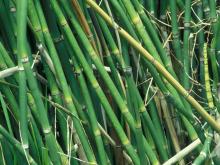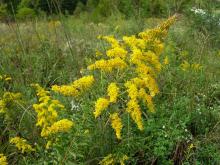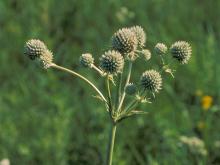Wildflowers, Grasses and Other Nonwoody Plants
Media

Species Types
Scientific Name
Equisetum (3 spp. in Missouri)
Description
Horsetails, or scouring rushes, are in the genus Equisetum. They’re easy to recognize with their jointed, hollow stems. Like ferns, they reproduce via spores instead of flowers and seeds.
Media

Species Types
Scientific Name
Solidago spp. (23 species in Missouri)
Description
There are 23 species of goldenrods in Missouri. They can be hard to identify to species, but as a group, the goldenrods are common and nearly unmistakable.
Media

Species Types
Scientific Name
Eryngium yuccifolium
Description
“It’s an odd plant,” this rattlesnake master, “with its leaves like yucca, a head like a thistle, and second cousin to the carrot.” That’s how the great prairie writer John Madson summed it up!
Media

Species Types
Scientific Name
All true grasses (species in the grass family)
Description
Missouri has 276 species in the grass family, including well-known crop plants and our native prairie grasses. Distinguishing between the species can be difficult, but it’s easy to learn some basics about the group.
Media

Species Types
Scientific Name
Polygala sanguinea
Description
The dense, cylindrical flower clusters of field milkwort are pink to white and, at first glance, look something like a clover head. This small annual wildflower is common in prairies, old fields, meadows, and glades.
Media

Species Types
Scientific Name
Solidago ptermicoides (formerly Aster ptarmicoides)
Description
With its white, petal-like ray florets and pale disc florets, upland white goldenrod is truly the oddball of the goldenrods: it looks like a white-flowered aster. Indeed, it used to be considered an aster.
Media

Species Types
Scientific Name
Symphyotrichum spp. (formerly Aster spp.)
Description
Missouri has 24 species of New World asters in genus Symphyotrichum. Most have purple or white ray flowers and yellow disk flowers that turn reddish over time. Most bloom in late summer and fall.
Media

Species Types
Scientific Name
Spartina pectinata
Description
Prairie cordgrass is a native perennial sod-forming grass with flowering stalks up to 7 feet tall. A grassland species, it grows in dense stands in low, damp soils. It’s often called ripgut because of the tiny sharp saw teeth on the leaf edges.
See Also
About Wildflowers, Grasses and Other Nonwoody Plants in Missouri
A very simple way of thinking about the green world is to divide the vascular plants into two groups: woody and nonwoody (or herbaceous). But this is an artificial division; many plant families include some species that are woody and some that are not. The diversity of nonwoody vascular plants is staggering! Think of all the ferns, grasses, sedges, lilies, peas, sunflowers, nightshades, milkweeds, mustards, mints, and mallows — weeds and wildflowers — and many more!





















